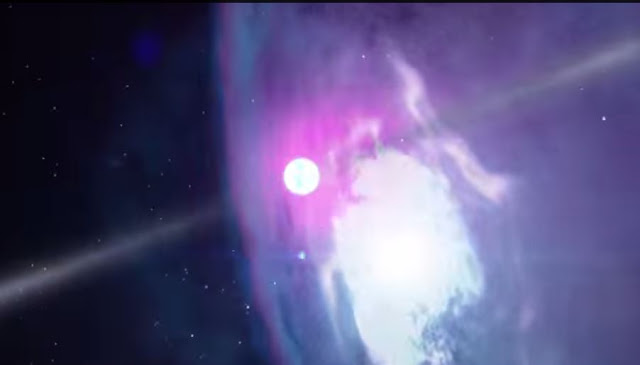| Online: | |
| Visits: | |
| Stories: |

| Story Views | |
| Now: | |
| Last Hour: | |
| Last 24 Hours: | |
| Total: | |
Cosmic Fireworks Expected from Rare Stellar Encounter In 2018 – Video
Credits: NASA’s Goddard Space Flight Center
J2032 was found in 2009 through a so-called blind search of LAT data. Using this technique, astronomers can find pulsars whose radio beams may not be pointed precisely in our direction and are therefore much harder to detect.
“Two dozen pulsars were discovered this way in the first year of LAT data alone, including J2032,” said David Thompson, a Fermi deputy project scientist at NASA’s Goddard Space Flight Center in Greenbelt, Maryland. “Nearly all of them would not have been found without Fermi.”
Once they knew exactly where to look, radio astronomers also were able to detect J2032. A team at the Jodrell Bank Centre for Astrophysics at the University of Manchester in the U.K. kept tabs on the object from 2010 through 2014. And they noticed something odd.
“We detected strange variations in the rotation and the rate at which the rotation slows down, behavior we have not seen in any other isolated pulsar,” said Andrew Lyne, professor of physics at the University of Manchester. “Ultimately, we realized these peculiarities were caused by motion around another star, making this the longest-period binary system containing a radio pulsar.”
The massive star tugging on the pulsar is named MT91 213. Classified as a Be star, the companion is 15 times the mass of the sun and shines 10,000 times brighter. Be stars drive strong outflows, called stellar winds, and are embedded in large disks of gas and dust.
“When we discovered this pulsar in 2009, we noticed that it was in the same direction as this massive star in the constellation Cygnus, but our initial measurements did not give any evidence that either star was a member of a binary system,” explained Paul Ray, an astrophysicist at the Naval Research Laboratory in Washington. “The only way to escape that conclusion was if the binary system had a very long orbital period, much longer than the longest known pulsar-massive star binary at the time, which seemed unlikely.”
Following an elongated orbit lasting about 25 years, the pulsar passes closest to its partner once each circuit. Whipping around its companion in early 2018, the pulsar will plunge through the surrounding disk and trigger astrophysical fireworks. It will serve as a probe to help astronomers measure the massive star’s gravity, magnetic field, stellar wind and disk properties.
Several features combine to make this an exceptional binary. Out of six similar systems where the massive star uses hydrogen as its central energy source, J2032′s has the greatest combined mass, the longest orbital period, and, at a distance of about 5,000 light-years, is closest to Earth.
“This forewarning of the energetic fireworks expected at closest approach in three years’ time allows us to prepare to study the system across the entire electromagnetic spectrum with the largest telescopes,” added Ben Stappers, a professor of astrophysics at the University of Manchester.
Astronomers think the supernova explosion that created the pulsar also kicked it into its eccentric orbit, nearly tearing the binary apart in the process. A study of the system led by Lyne and including Ray and Stappers was published June 16 in the journal Monthly Notices of the Royal Astronomical Society.
Lynn Chandler
Source:




